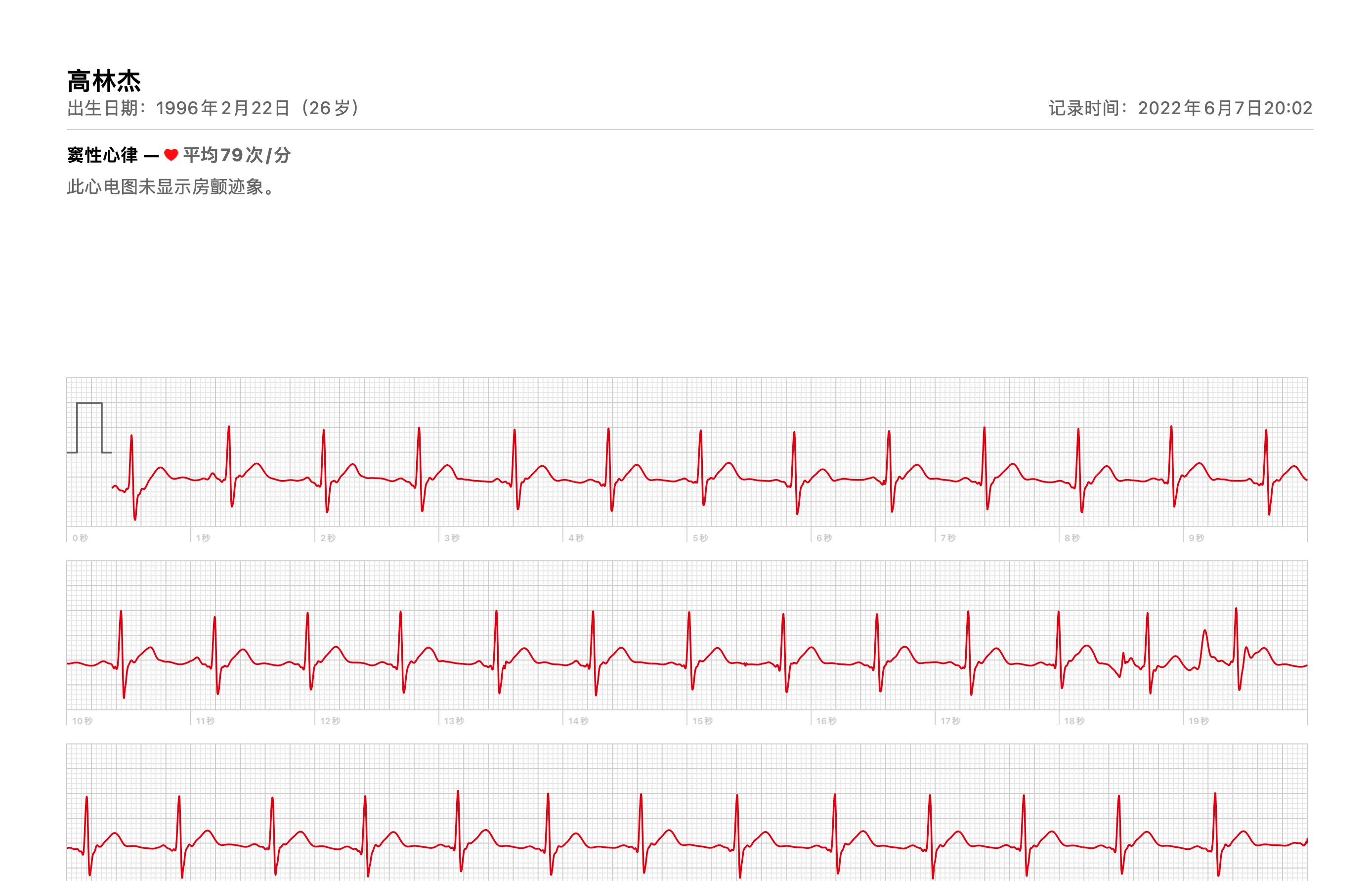Appearance
心率动画
目标是画一个根据真实心率跳动的心脏
准备
- 跳动的心脏
- Apple Watch
- 生成心率图
- 分析心跳曲线,生成动画方案
- 画图
生成心率图
Apple Watch 现在支持了收集心率信息绘制 pdf 报表 
转化矢量图
观察到心率曲线放大有断点,预计是用矢量图绘画,上网搜了一下 pdf 转 svg 的方案,找到一个在线网站 https://cloudconvert.com/pdf-to-svg 尝试直接转换成 svg 成功。
提取对应曲线片段代码
我们需要去掉多余部分只保留心跳曲线部分,阅读 svg 代码即可,转换结果比较清晰。
提取内容后会有大量留白,调整大小即可
分析心跳曲线 生成动画方案
采样数据点
参考这篇文章,使用 getTotalLength 和 getPointAtLength 取样。
export function sample(g: SVGGeometryElement, precision: number = 0.1): Point[] {
const res: Point[] = [];
const length = g.getTotalLength();
let i: number;
for (i = 0; i < length; i += precision) {
const { x, y } = g.getPointAtLength(i);
res.push({ x, y });
}
if (i > length) {
const { x, y } = g.getPointAtLength(length);
res.push({ x, y });
}
return res;
}
数据采样后,直接将横纵坐标线性映射到 [0, 1] 区间即可。
export function normalize(points: Point[]): Point[] {
const { min: { x: minX, y: minY }, max: { x: maxX, y: maxY } } = statistics(points);
const lx = maxX - minX;
const ly = maxY - minY;
return points.map(({ x, y }) => ({
x: (x - minX) / lx,
y: (y - minY) / ly,
}));
}
生成动画方案
将心跳曲线横坐标视为时间,纵坐标视为动画幅度,即可生成一个单维度动画幅度的方案。其中有一个问题,由于采样函数在曲线长度上是等差,横坐标可能分布不均匀, 使用线性插值的方式计算计算实际动画幅度。
使用 requestAnimationFrame 控制动画过程
import { linear, Point } from "./sample";
export type AnimationCallback = (point: Point) => void
export type AnimationCanceller = (newDuration?: number) => void
export interface AnimationFunction {
(cb: AnimationCallback): AnimationCanceller;
}
function computeFactor(points: [Point, Point], progress: number): number {
const [a, b] = points;
const l = b.x - a.x;
return (progress - a.x) / l;
}
export function animate(points: Point[], duration: number, forever: boolean = true): AnimationFunction {
return (cb) => {
let i = 0;
let cur: number = 0;
let curTime: number | undefined = undefined;
let handler: number | undefined = undefined;
function run(progress: number) {
let finalPoints: [Point, Point];
while (points[i + 1].x < progress && i < points.length - 1) {
i += 1;
}
if (i < points.length - 1) {
finalPoints = [points[i], points[i + 1]];
} else {
finalPoints = [points[i], points[i]];
}
cb(linear(finalPoints, computeFactor(finalPoints, progress)));
curTime = curTime ?? performance.now();
handler = requestAnimationFrame((time) => {
const diff = time - curTime!;
curTime = time;
cur += diff / duration;
if (cur <= 1) {
run(cur);
} else if (forever) {
cur = 0;
i = 0;
run(cur);
}
});
}
run(cur);
return (newDuration?: number) => {
if (typeof newDuration !== "undefined") {
duration = newDuration;
} else {
if (typeof handler !== 'undefined') {
cancelAnimationFrame(handler);
}
}
};
};
}
画图
有了动画方程,画图就比较简单了,回调时改动对应属性即可
const fn = animate(normalize(points), 10000);
const reset = fn(point => {
lineLeft.value = min.x + size.x * point.x + 1.5 - indicatorSize / 2 + 'px';
left.value = min.x + size.x * point.x - indicatorSize / 2 + 'px';
top.value = min.y + size.y * point.y - indicatorSize / 2 + 'px';
scale.value = 1 + point.y * 0.618;
color.value = 127 + 255 * point.y / 2;
});